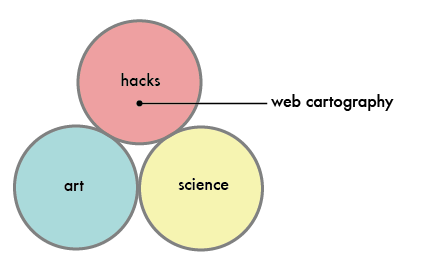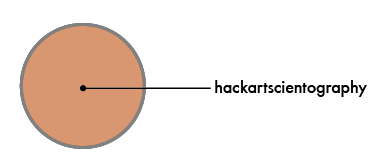Apart from being dead, Art and Science are strong in web cartography.
The other day Tim Wallace provoked a bit of Twitter conversation about the role of art in web cartography by way of a snarky, pessimistic Venn diagram on the subject; and having been forced into spelling out some of his thoughts in more detail, he has solicited some of us other nerds to write our points of view.
I cracked a beer and started to outline some points in response to Tim’s post but decided it wasn’t worthwhile to attempt to talk about the finer points. Everything hinges on people’s differing definitions of “art.” I ended up progressing through three stages of thought on art and science in web cartography, presented here with sweeping generalizations, ridiculous exaggerations, offensive assertions, and my dumb versions of Tim’s original diagram. (Do read his post first.)

There is plenty of art and science in web cartography.
They’re just not in the process of cartography where Tim was mostly looking. In terms of aesthetics, web cartography is just as capable of being an art as anything; it just, as always in history, is accomplished with the latest tools. But if art were only a matter of aesthetics, the “my five year old could paint that” genre wouldn’t exist. Art is not necessarily in the map itself, nor its execution, and neither is science. During a moment’s break from his one million word dissertation, Robert Roth suggested to me these definitions of art, science, and cartography (in terms of ontology and epistemology, as academics are required to do):
Cartography is the art and science of mapmaking and map use.
Under this definition, mapmaking and map use are the ontologies; they are the bodies of knowledge to which academicians contribute and from which mapmakers and map users draw. These corpora clearly overlap, particularly in the case when map user is mapmaker. Art and science are the epistemologies; they are the ways of knowing or the methods of constructing new knowledge about how maps can/should be made or used.
I can get on board with that (although that language implies to me that pretty much anything is an art and science) if we want to get too philosophical to bother arguing over anything, the eventual point being that all this is at a different level from the actual act of designing and making a map, and that in this there is probably no difference between web cartography and any other cartography. To be a litte more down-to-earth, though, I won’t hold such a fundamental view of art and science, and would generally consider them to include the knowledge itself. The science is, say, How Maps Work, and it, along with whatever art is, informs and guides map design, on the web or anywhere else. But this assumes that “web cartography” really is like cartography as we usually know it. Maybe it’s not.

There is neither art nor science in web cartography.
This is the first of two rude things I will say: web cartography is unartistic and unscientific. The common “cartographer” on the web is either a machine or simply the final human element of everything that goes into a map—the mapmaker. The word itself doesn’t seem as common as it used to be, but the mash-up is still the heart of web cartography. The web map, in my mind, is all about combining your data with someone else’s base map, or your design with someone else’s data, and so on. When I make a map by coloring a bunch of polygons on top of Google Maps, have I done anything artistic or scientific? Art and science entered into the equation somewhere along the line (say, when Google designed their map tiles), but it probably wasn’t at my stage, and I’m probably (definitely) going against some good judgments that would follow from them. Despite all the good, artistically brillant and scientifically sound design out there, “web cartography,” if you ask me, is about the retrieval, mingling, and dissemination of data, at times almost willfully at the expense of cartography’s artistic and scientific roots. Web cartography is not about maps; it’s about hacks for moving data around. But hey, most of the time that’s just fine.

Who cares?
Having stated the above two perspectives, rude statement number two: so what? To even fret the “displacement of art” in web cartography (to quote Tim) is to be a traditionally trained cartographer grasping at relevance in the modern world. I like to take this cynical view often (recognizing that I too am just such a cartographer, but at least being real about it) when I see some of my ilk talking about the current wave of amatuer, so-called neocartography, typically to explain why it’s all badly designed or simply wrong. Web cartography, I generally hold, is what it is, gets the job done, and will evolve into something that incorporates the best of art and science. But I admit that it’s hard not to be bothered by moves in the wrong direction. “Art” being nigh impossible to definitively identify, I’d more point to science as the thing being marginalized in web cartography. Take, for example, the bit of excitement seen on Twitter the other day over a Where 2.0 workshop on Google Fusion Tables, which make it easy to load data into what is apparently being called an intensity map. Here is a deliberate advancement in the creation of what cartographic science would deem, well, bad maps. (Inappropriate map projection, a confusion of semi-transparent colors and basemap details, &c.) We do what we can with the technology available and that’s fine, but at some point we’ll have to make the transition from developing technology that makes what we are doing easier to developing technology that makes what we should be doing easier. Perhaps I’ll choose to care this time.
– – – –
Other writing in this inter-blog series: Tim Wallace, Daniel Huffman, and hopefully more to come.

4 Comments